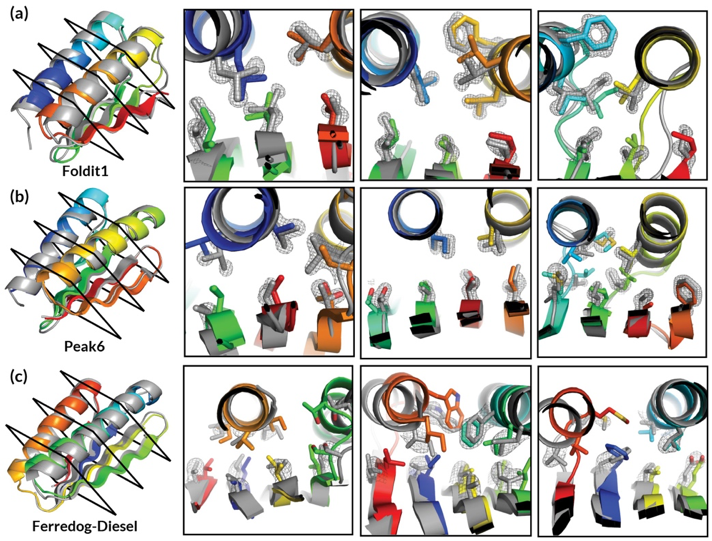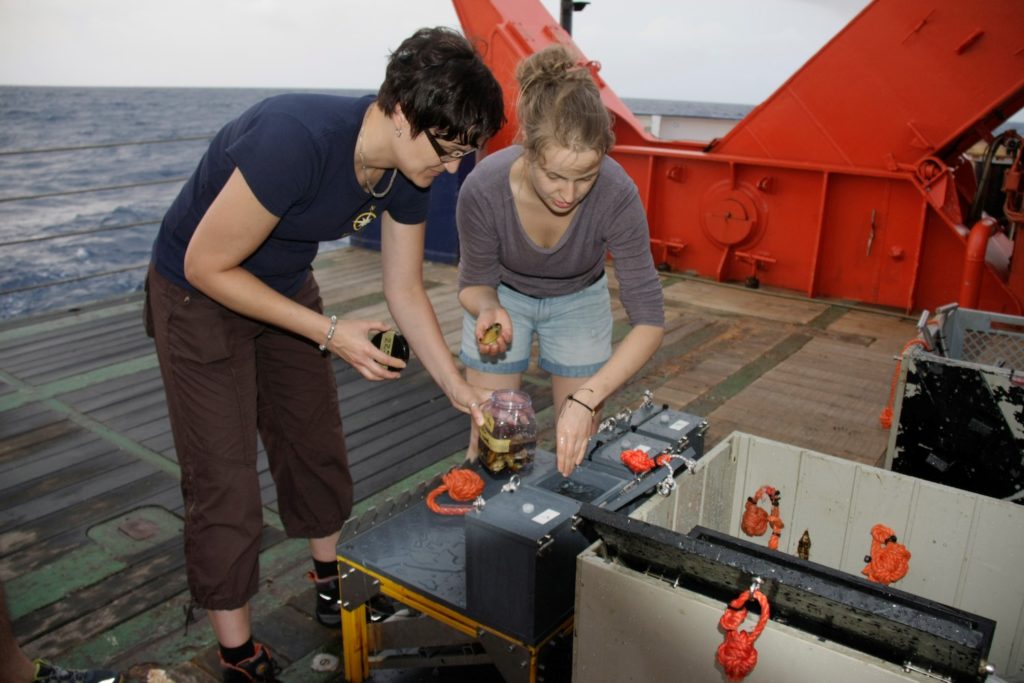A human protein co-regulation map reveals new insights into protein functions
Tag: Microbiology
Eelgrass acid and resveratrol produced by cell factories for the first time
Scientists are now able to produce a wide range of sulfated aromatic compounds such as antifouling eelgrass acid, resveratrol and vanillic acid derivatives using microbial production hosts
Shark skin microbiome resists infection
A survey of the shark skin microbiome provides the first step toward understanding the remarkable resilience of shark wounds to infection. In the wild, blacktip reef sharks are often seen bearing wounds, but they rarely exhibit obvious signs of infection…
Eelgrass acid and resveratrol produced by cell factories for the first time
Scientists are now able to produce a wide range of sulfated aromatic compounds such as antifouling eelgrass acid, resveratrol and vanillic acid derivatives using microbial production hosts
Microbiologist Karen Lloyd awarded $2.5M grant for permafrost research
Karen Lloyd, an associate professor of microbiology at the University of Tennessee, Knoxville, has received a $2.5 million grant from the Department of Energy to conduct research on the effects of thawing permafrost on the environment. Permafrost–ground that remains below…
Microbiologist Karen Lloyd awarded $2.5M grant for permafrost research
Karen Lloyd, an associate professor of microbiology at the University of Tennessee, Knoxville, has received a $2.5 million grant from the Department of Energy to conduct research on the effects of thawing permafrost on the environment. Permafrost–ground that remains below…
Eelgrass acid and resveratrol produced by cell factories for the first time
Scientists are now able to produce a wide range of sulfated aromatic compounds such as antifouling eelgrass acid, resveratrol and vanillic acid derivatives using microbial production hosts
Microbiologist Karen Lloyd awarded $2.5M grant for permafrost research
Karen Lloyd, an associate professor of microbiology at the University of Tennessee, Knoxville, has received a $2.5 million grant from the Department of Energy to conduct research on the effects of thawing permafrost on the environment. Permafrost–ground that remains below…
Agri-Neo launches Neo-Temper™ to prevent flour recalls through pathogen-reduction process
Organic, validated non-thermal food safety solution easily integrates into existing tempering process; preserves nutrition, sensory and functional characteristics of both hard and soft wheat flours
Shark skin microbiome resists infection
A survey of the shark skin microbiome provides the first step toward understanding the remarkable resilience of shark wounds to infection. In the wild, blacktip reef sharks are often seen bearing wounds, but they rarely exhibit obvious signs of infection…
Agri-Neo launches Neo-Temper™ to prevent flour recalls through pathogen-reduction process
Organic, validated non-thermal food safety solution easily integrates into existing tempering process; preserves nutrition, sensory and functional characteristics of both hard and soft wheat flours
Shark skin microbiome resists infection
A survey of the shark skin microbiome provides the first step toward understanding the remarkable resilience of shark wounds to infection. In the wild, blacktip reef sharks are often seen bearing wounds, but they rarely exhibit obvious signs of infection…
Agri-Neo launches Neo-Temper™ to prevent flour recalls through pathogen-reduction process
Organic, validated non-thermal food safety solution easily integrates into existing tempering process; preserves nutrition, sensory and functional characteristics of both hard and soft wheat flours

Science Snapshots from Berkeley Lab
Gamers designing proteins, raw food changing the gut, and a toxin-absorbing MOF
A weapon to make a superbug to become more deadly
A recent research led by a scientist at City University of Hong Kong (CityU) has discovered an easily transmitted DNA piece that can make a new type of hyper-resistant and deadly superbug become hyper-virulent quickly, posing an unprecedented threat to…
Point-of-care diagnostic for detecting preterm birth on horizon
Washington, DC – October 22, 2019 – A new study provides a first step toward the development of an inexpensive point-of-care diagnostic test to assess the presence of known risk factors for preterm birth in resource-poor areas. The study found…
Stingless bee species depend on a complex fungal community to survive
A report published in PLOS ONE describes key roles of various microorganisms in the development of the larvae of Scaptotrigona depilis. Researchers warn that this symbiotic relationship is threatened by the indiscriminate use of pesticides.
$1.2 million in grants to fund search for diabetes cure
BINGHAMTON, NY – A biomedical engineering professor at Binghamton University, State University of New York is trying to find a cure for diabetes from several different angles, and three federal grants totaling nearly $1.2 million will aid her and her…
Resistance to last resort drug arose in patient over 3 weeks
Washington, DC – October 21, 2019 – French investigators have described development of resistance to one of the last resort therapies used to treat extremely drug-resistant Pseudomonas aeruginosa. That resistance arose in a single patient over a scant 22 days.…
Bacteria must be ‘stressed out’ to divide
A new study from EPFL scientists has found that bacteria use mechanical forces to divide, along with biological factors. The research, led by the groups of John McKinney and Georg Fantner at EPFL, came after recent studies suggested that bacterial…
DNA-reeling bacteria yield new insight on how superbugs acquire drug-resistance
A new imaging method invented at Indiana University leads to a discovery about how bacteria use thin hair-like surface appendages called pili for ‘natural transformation’
Cell stiffness may indicate whether tumors will invade
Study shows tumors with softer, larger cells at their periphery are more likely to spread; may suggest new route for cancer therapy
From waste to wealth: Researchers to transform anaerobic digestion
Multi-institutional team awarded $5.1 million by Department of Energy to tackle the organic waste problem
Rice blast fungus discovery will drive crop innovation
A secret weapon used by the killer rice blast fungus to infect host plants has been discovered in new research. Rice blast is the most serious disease of rice and is caused by the fungus Magnaporthe oryzae. Each year, blast…
Toxoplasmosis: Preventing mother-to-child transmission
INRS Professor Maritza Jaramillo receives $700,000 from CIHR to fight against Toxoplasma gondii
Researchers leverage new grant to benefit climate, cows
New England scientists will test algae for dietary supplements to decrease methane emission by cattle
Computational ‘match game’ identifies potential antibiotics
CMU software tool speeds discovery using microbial datasets
Taming the wild cheese fungus
Washington, DC – October 15, 2019 – The flavors of fermented foods are heavily shaped by the fungi that grow on them, but the evolutionary origins of those fungi aren’t well understood. Experimental findings published this week in mBio offer…
New journal to explore the ‘mysterious ecosystem’ in our gut
A new open access journal from Cambridge University Press, published in partnership with The Nutrition Society, will explore the vital interaction between people and the complex community of microorganisms that live in our digestive systems. The journal, Gut Microbiome ,…
New research to boost global date fruit production
New major project aims to improve global date palm production and protection
Many cooks don’t spoil the broth: Manifold symbionts prepare the host for any eventuality
Deep-sea mussels harbor up to 16 different strains of bacteria in their gills, keeping them prepared for environmental changes
Tiny droplets allow bacteria to survive daytime dryness on leaves
Bacteria on the surface of leaves survive dryness during the day by huddling in tiny droplets — a finding that may help scientists support microbiome health in crops and natural plants

Many cooks don’t spoil the broth: Manifold symbionts prepare their host for any eventuality
Deep-sea mussels, which rely on cooperative symbiotic bacteria for their food, harbor a surprisingly high diversity of these bacterial “cooks”: Up to 16 different bacterial strains live together in the mussel’s gills, each with its own abilities and strengths. Thanks to this diversity of symbiotic bacterial partners, the mussel is prepared for all eventualities. The mussel bundles up an all-round carefree package, a German-Austrian research team including Jillian Petersen from the University of Vienna and Rebecca Ansorge and Nicole Dubilier from the Max-Planck-Institute for Marine Microbiology now reports in Nature Microbiology.
Study reveals how mucus tames microbes
Specialized sugar molecules called glycans can disarm opportunistic pathogens and prevent infection
Deciphering the early stages of Parkinson’s disease is a matter of time
The secret to deciphering elderly disorders is understanding how key proteins organize themselves over time
Family of crop viruses revealed at high resolution for the first time
For the first-time we can take a molecular-level look at one of the world’s deadliest crop killers. The Luteoviridae are pathogenic plant viruses responsible for major crop losses worldwide. Transmitted by aphids, the viruses infect a wide range of food…
Compound in breast milk fights harmful bacteria
Simple, inexpensive compound could be added to formula or cow’s milk
CRISPR enzyme programmed to kill viruses in human cells
Researchers harness Cas13 as an antiviral and diagnostic for RNA-based viruses
Biomedical sciences researchers isolate gut bacteria that can prevent and cure rotavirus infection
ATLANTA–The presence of specific microbiota, or microorganisms that live in the digestive tract, can prevent and cure rotavirus infection, which is the leading cause of severe, life-threatening diarrhea in children worldwide, according to a new study by the Institute for…
CNIO and University of Wurzburg solve 3D structure of ‘nanomachine’ that makes tuberculosis virulent
The long-awaited finding is published in Nature
Fruit flies help in the development of personalized medicine
People with the same diagnosis typically receive a standard treatment that is not necessarily effective for everyone. With knowledge of the individual patient’s genome, it may be possible in the future to a greater extent to target the medical treatment…
Identifying a cyanobacterial gene family that helps control photosynthesis
A new Michigan State University study has identified a family of genes in cyanobacteria that help control carbon dioxide fixation. The discovery furthers our basic knowledge of photosynthesis. It also opens new doors to design systems for sustainable biotech production.…
DNA metabarcoding useful for analyzing human diet
Washington, DC – October 8, 2019 – A new study demonstrates that DNA metabarcoding provides a promising new method for tracking human plant intake, suggesting that similar approaches could be used to characterize the animal and fungal components of human…
Nodulation connected to higher resistance against powdery mildew in legumes
St. Paul, Minnesota–Scientists have long known that nodulation is important to plant health. Nodulation occurs when nodules, which form on the roots of plants (primarily legumes), form a symbiotic relationship with nitrogen-fixing bacteria that deliver nutrients to the plant. This…
The cholera bacterium can steal up to 150 genes in one go
In 2015, EPFL researchers led by Melanie Blokesch published a seminal paper in Science showing that the bacterium responsible for cholera, Vibrio cholerae , uses a spring-loaded spear to literally stab neighboring bacteria and steal their DNA. They identified the…
Microbiome provides new clues to determining development of colon cancer
A team from the George Washington University published research in the journal Gastroenterology, which found a connection between bacterial species living in the microbiome and development of colon cancer
Weak spot in pathogenic bacteria
ClpX-ClpP protein complex could be starting point for new antibiotics
New bioinformatics hub at UChicago enables next-gen infectious disease research
NIH-funded resource merges pathogen databases and adds AI capabilities
Complete genome of devastating soybean pathogen assembled
An international research collaboration has successfully assembled the complete genome sequence of the pathogen that causes the devastating disease Asian soybean rust. The research development marks a critical step in addressing the threat of the genetically-complex and highly-adaptive fungus Phakopsora…
Uncovering drug-like small molecules in the human microbiome
Gene clusters once hidden in the human microbiome, whose products resemble clinically used drugs, are now more discoverable, thanks to a new bioinformatics approach. Dubbed MetaBGC, it may be useful for “bioprospecting” human microbiome samples for genes whose protein products…